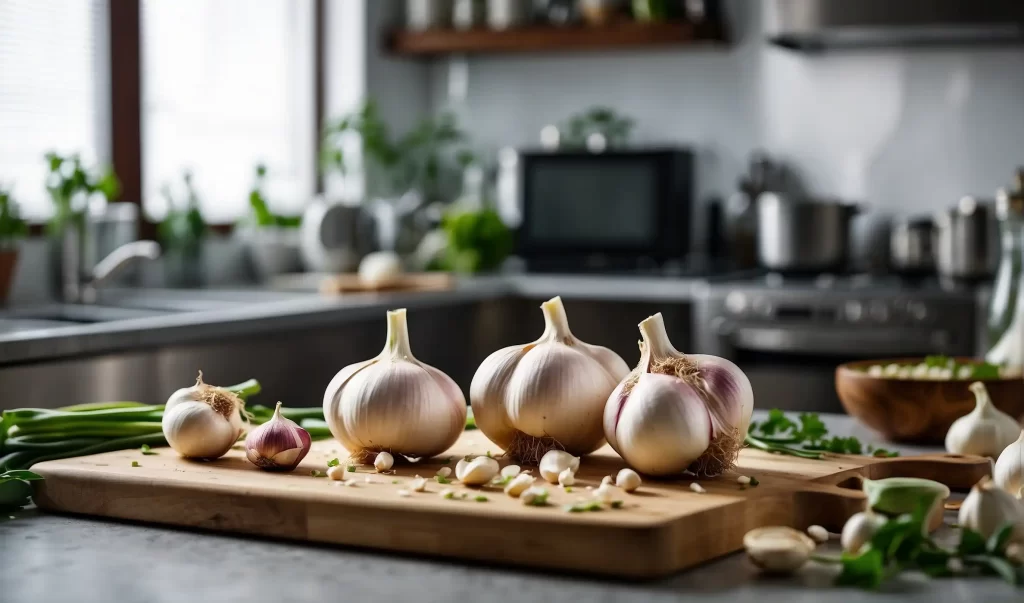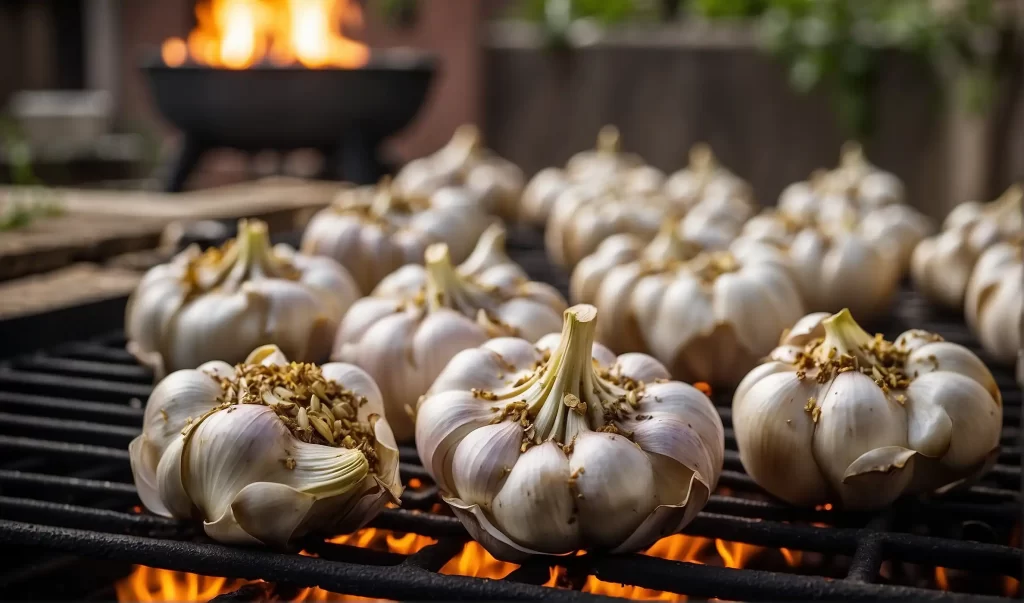To roast elephant garlic, slice off the top to expose cloves, drizzle with olive oil, wrap in foil, and bake at 400°F for 30-40 minutes. Elephant garlic, with its milder flavor compared to regular garlic, becomes even sweeter and more mellow when roasted.
Roasting elephant garlic transforms it into a soft, spreadable treat that can elevate any dish that calls for garlic. Rich in antioxidants and with numerous health benefits, this giant cousin of traditional garlic is a favorite among chefs and home cooks alike.
Its larger cloves make it a breeze to peel and prepare, providing a subtle, slightly sweet flavor to your recipes. Integrating roasted elephant garlic into your culinary repertoire not only adds depth to your dishes but also offers a conversation piece at the dinner table—its impressive size is always a surprise for those unfamiliar with it. Whether spread on crusty bread or used as a secret ingredient in sauces, roasting elephant garlic unlocks its potential, making it a simple yet luxurious addition to your cooking arsenal.
Elephant Garlic Roasting Basics
Understanding the different varieties of elephant garlic is crucial for a successful roast. Unlike its smaller counterparts, elephant garlic boasts larger cloves and a milder flavor. Recognizing the subtle differences in flavor profiles and cloves sizes ensures a tailor-fit roasting approach for each type.
Selecting high-quality bulbs sets the foundation for delicious roasted garlic. Look for firm, plump bulbs with dry, intact outer skins. Bulbs should be free of soft spots and visible mold, indicating they are fresh and not deteriorated.
Roasting requires a well-prepared kitchen. Ensure your oven is preheated to the appropriate temperature, typically around 400°F (200°C). You’ll need foil or a baking dish, high-quality olive oil, and fresh herbs if desired. Maintaining cleanliness and organization during the process will yield the best roasting results.
Anatomy Of Elephant Garlic
Elephant garlic, despite its name, isn’t actually a true garlic. It’s more closely related to the leek family, which explains its larger size and milder flavor when compared to regular garlic. While regular garlic bulbs are small with multiple cloves, elephant garlic produces a significantly larger bulb, typically with only about four to six cloves each.
Roasting elephant garlic amplifies its sweetness and less pungent taste, making it an excellent addition to a variety of dishes. Its milder flavor is favored by those who find regular garlic to be too strong.
Health benefits of roasted elephant garlic include its ability to help reduce cholesterol levels, boost the immune system, and provide anti-inflammatory benefits. It’s a powerhouse of nutrients, with antioxidants, vitamins, and minerals that can help maintain good heart health and improve overall well-being.
Pre-roasting Essentials
To ensure a successful roast of elephant garlic, selecting the appropriate tools and equipment is crucial. An oven with a reliable temperature setting is indispensable, and a baking sheet or ovenproof dish is needed to hold the cloves. Aluminum foil or parchment paper can be used for covering, aiding in the even distribution of heat and retaining moisture. Sharp knives and a cutting board are necessary for prepping the garlic.
Before the actual roasting begins, it’s essential to clean and prepare the elephant garlic correctly. Start by carefully peeling away the outer layers, leaving the individual cloves intact but exposed. With a sharp knife, slice a small portion off the top of each clove to expose the raw garlic, enhancing its ability to absorb flavors and caramelize evenly during roasting. Always thoroughly rinse the cloves to remove any dirt or debris, and pat them dry before proceeding to cook.
Seasoning Techniques Before Roasting
Elevating the flavor of elephant garlic is simple with the right herbs and spices. Explore combining rosemary, thyme, or oregano to infuse your garlic with aromatic undertones. For a bolder taste, consider adding a dash of smoked paprika or cayenne pepper which can offer a warm, spicy kick. Utilizing fresh herbs will often yield a more vibrant flavor profile compared to dried versions.

Complement these spices with the right oils and butters to not only enhance taste but also aid in creating a perfect roast. Opt for extra virgin olive oil for its robust flavor or clarified butter for a hint of nuttiness. These fats can help to evenly distribute heat during roasting, resulting in a tender, succulent final product. Some exotic choices like truffle oil can add a unique gourmet finish to your dish.
How to Roast Elephant Garlic
Roasting elephant garlic requires following a simple yet precise method to maximize flavor and texture. Begin by preheating your oven to 400 degrees Fahrenheit (200 degrees Celsius). While the oven warms, trim the top off the bulb to expose individual cloves. Drizzle cloves with quality olive oil and season with salt. Wrap the prepared bulb in aluminum foil and place it in the oven.
| Garlic Size | Roasting Time |
|---|---|
| Small Bulb | 30-35 minutes |
| Medium Bulb | 35-40 minutes |
| Large Bulb | 40-45 minutes |
Check the garlic after the recommended time by testing its tenderness with a fork. Once the cloves feel soft and buttery, remove from the oven and let it cool slightly. The cloves should now easily squeeze out of their skins, ready to spread on crusty bread or enhance your favorite dish with its rich, caramelized flavor.

Finding the Perfect Roast
Roasting elephant garlic to the perfect level of doneness can elevate your dish to new heights of flavor. Begin by preheating your oven to 400°F (200°C). As you prepare the garlic, consider drizzling it with a quality olive oil and a pinch of salt, to enhance its natural taste. Elephant garlic requires a longer cooking time due to its larger size, so aim for about 30-40 minutes.
Ensuring your garlic reaches the perfect consistency involves periodic checking. Halfway through the roasting process, take a moment to check the texture with a fork. The garlic should be tender and caramelizing at the edges but not burning. If it feels firm, continue roasting and check again periodically. Once done, the elephant garlic should be deeply golden, soft, and spreadable – a true delight for the taste buds.
Post-roast Handling
Roasting elephant garlic can elevate many dishes with its milder, sweeter flavors. Once out of the oven, immediately transfer hot garlic to a heat-resistant surface using oven mitts or a sturdy spatula. This precaution helps avoid burns and kitchen accidents.
For optimal cooling, spread the cloves out on a wire rack allowing air to circulate freely, which minimizes condensation and the risk of mold. If pressed for time, place them in front of a fan to expedite the process. After cooling to room temperature, store them in a dry, well-ventilated area to maintain freshness. Ideally, elephant garlic should be kept in a mesh bag or a papery husk within a dark location to extend shelf life.
Learn more: What Not to Plant After Garlic
Ways to Serve Roasted Elephant Garlic
Roasted Elephant Garlic elevates many dishes with its milder and sweeter flavor profile compared to regular garlic. It is incredibly versatile and enhances the taste of a variety of foods. For a delightful spread, mash the roasted cloves on warm, crusty bread as a simple yet delicious appetizer. Alternatively, incorporate the garlic into compound butter, adding a rich, aromatic twist to grilled meats or steamed vegetables.
The soft, caramelized cloves of elephant garlic can also be the perfect accompaniment to a cheese platter, pairing well with semi-hard cheeses, such as Gouda or Cheddar. This roasted delight is equally at home in vegan dishes, where it can be transformed into a savory vegan aioli to drizzle over roasted vegetables or as a dip. When considering wines, roasted elephant garlic complements the fruity notes of a light-bodied red, such as Pinot Noir, or the crispness of a dry white wine like Sauvignon Blanc, to cut through the richness and tantalize the palate.
Maintaining Roasted Garlic Quality
Preserving the full-bodied flavor and ideal texture of roasted elephant garlic is paramount for culinary enthusiasts. To maintain freshness directly post-roasting, ensure that the garlic cools completely before storage. Short-term preservation is simple; place the garlic in an airtight container and refrigerate for up to two weeks. For those aiming to extend the shelf life, freeze roasted garlic either whole or as a paste. Partition into small portions in a plastic wrap or an ice cube tray before transferring into freezer bags. This method locks in the robust flavors for several months, providing quick access to high-quality elephant garlic for a variety of dishes.
Troubleshooting Common Roasting Issues
Roasting elephant garlic to perfection requires monitoring to prevent under or over-roasting. A lightly browned exterior and a soft, creamy interior indicate the right balance. To address under-roasting, extend the cooking time in small increments, checking frequently. For over-roasting, it’s essential to start with a lower temperature and increase gradually, as elephant garlic has a tendency to go from perfectly roasted to burnt quickly.
Uneven cooking often results from inconsistent bulb sizes or variable oven hotspots. Cut larger bulbs into smaller, uniform pieces and rotate the tray periodically. Using a meat thermometer can help gauge doneness throughout the different sections of the garlic. The ideal internal temperature should reach approximately 205°F (96°C). Using these techniques ensures each bulb is evenly cooked, providing the perfect texture and flavor.
Read more: Do Cats Like Garlic Smell
FAQs For How To Roast Elephant Garlic
What Is Elephant Garlic?
Elephant garlic is not true garlic but a type of perennial bulb closely related to leeks. It has a milder flavor compared to regular garlic and produces large, impressive cloves that are ideal for roasting.
How Long To Roast Elephant Garlic?
To roast Elephant Garlic, it typically takes about 30-40 minutes at 400 degrees Fahrenheit. The cloves should become soft and golden brown when done, which brings out their sweet, nutty flavor.
Can You Eat Elephant Garlic Raw?
Yes, you can eat Elephant Garlic raw. Just like regular garlic, it can be chopped or sliced and used in salads or as a topping. However, its flavor is milder than regular garlic, making it more palatable raw.
What Are The Health Benefits Of Elephant Garlic?
Elephant Garlic has similar health benefits to regular garlic. It is thought to support the immune system, contribute to heart health, and have antimicrobial properties. However, scientific evidence may not be as extensive as for true garlic.
Conclusion
Roasting elephant garlic transforms it into a mellow, sweet delight. This simple culinary technique elevates your dishes with minimal effort. Remember, low heat and patience are key. Enjoy the softened cloves spread on toast or infused in your favorite recipes.
For the latest in innovative culinary techniques and sustainable agriculture, keep up with Farm Pioneer, where delicious cooking meets green farming.
Ready to savor the gentle, aromatic flavor? Happy roasting!
